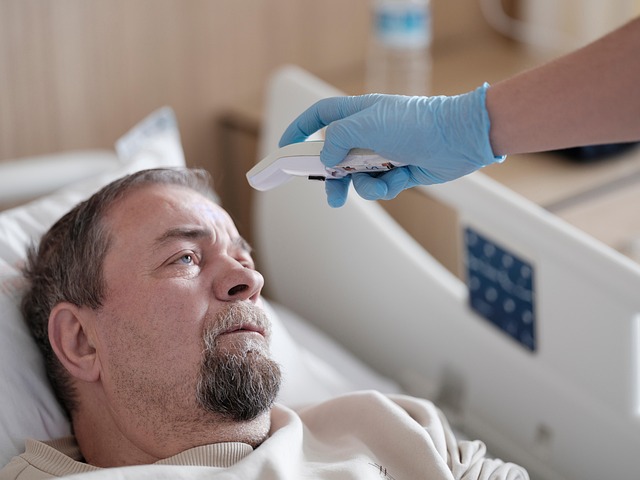Sleep Coaching for Early Sobriety: Transforming Rest and Well-being Near You
Individuals in early sobriety often face insomnia and fatigue due to disrupted sleep patterns from s…….
Over 15% US adults have used prescription painkillers not prescribed to them.
In today’s complex healthcare landscape, the concept of co-occurring disorder treatment has gained significant prominence. This approach recognizes and addresses multiple mental health conditions or disorders that often coexist within an individual. “Co-occurring disorder treatment centers near me” refers to specialized facilities or programs designed to provide comprehensive care for these complex cases, offering hope and healing to those struggling with simultaneous challenges. This article aims to guide readers through the intricate world of co-occurring disorder treatment, exploring its definition, global impact, economic implications, technological innovations, regulatory frameworks, and future potential. By delving into these aspects, we will gain valuable insights into why these centers are becoming increasingly vital in ensuring better mental health outcomes for individuals worldwide.
A co-occurring disorder treatment center is a specialized healthcare facility or program that focuses on individuals experiencing two or more mental health disorders simultaneously. These disorders can include conditions such as depression, anxiety, substance use disorders, bipolar disorder, schizophrenia, post-traumatic stress disorder (PTSD), eating disorders, and many others. The primary goal of these centers is to provide integrated treatment plans that address all coexisting conditions holistically.
The core components of a successful co-occurring disorder treatment program typically include:
Comprehensive Assessment: A thorough evaluation of the individual’s mental health history, including past and present disorders, to develop an accurate treatment plan.
Individualized Treatment Plans: Tailored interventions that may involve therapy (e.g., cognitive-behavioral therapy, dialectical behavior therapy), medication management, group counseling, family involvement, and lifestyle changes.
Integrated Care: Collaboration between various mental health professionals to ensure all aspects of an individual’s treatment are coordinated and consistent.
Supportive Services: Additional resources such as case management, peer support groups, education, vocational training, and housing assistance to facilitate a person’s recovery journey.
The concept of co-occurring disorder treatment has evolved over time, reflecting advancements in mental health research and a growing understanding of the complexities of human psychology. Historically, mental health care often treated disorders in isolation, with little consideration for comorbidity. However, studies in the late 20th century began to highlight the prevalence and impact of co-occurring disorders, leading to a paradigm shift in treatment approaches.
In the early 2000s, the National Institute on Drug Abuse (NIDA) and other research institutions started focusing extensively on understanding the relationship between substance use disorders and other mental health conditions. This led to the development of more comprehensive treatment models, eventually shaping the modern co-occurring disorder treatment center concept. Today, these centers are integral to the national healthcare systems of many countries, recognizing that treating a single disorder while ignoring others can lead to poorer outcomes and increased healthcare costs.
Co-occurring disorder treatment centers have a significant global impact, with various countries adopting models adapted to their specific cultural and healthcare contexts. The World Health Organization (WHO) has recognized the importance of integrated care for mental health disorders, emphasizing the need for coordinated services to address co-morbidity effectively. This has led to initiatives promoting the development of such treatment centers worldwide.
| Region | Trends |
|---|---|
| North America | A growing number of specialized co-occurring disorder treatment facilities, particularly in urban areas, serving a diverse range of populations. |
| Europe | Increasing integration of mental health services within primary care settings, leading to better access to co-occurring disorder treatments. |
| Asia Pacific | Rising awareness and investment in mental health care, with some countries establishing comprehensive networks of treatment centers focusing on cultural sensitivity. |
| Middle East & Africa | Expanding private sector involvement in mental health care, along with government initiatives to improve access to integrated treatment services. |
These regional trends reflect the unique challenges and opportunities in each area, demonstrating the global reach and importance of co-occurring disorder treatment centers.
The market for co-occurring disorder treatment centers is dynamic and growing, driven by increasing awareness of mental health issues and the recognition of the associated economic burdens. According to a report by Grand View Research, the global mental health care market size was valued at USD 386.4 billion in 2020 and is expected to expand at a compound annual growth rate (CAGR) of 7.9% from 2021 to 2028. Within this market, co-occurring disorder treatment services are gaining significant traction due to their ability to improve long-term patient outcomes and reduce healthcare costs.
Private equity firms and venture capital investors have shown a growing interest in mental health care startups, including those offering co-occurring disorder treatments. This influx of investment has fueled the development of innovative programs and facilities, particularly in North America and Western Europe. Government funding also plays a crucial role, with many countries allocating resources to expand access to integrated treatment services, especially for vulnerable populations.
By addressing multiple disorders simultaneously, co-occurring disorder treatment centers can significantly reduce healthcare costs over the long term. Research suggests that integrated care models can lower readmission rates, decrease emergency room visits, and improve overall patient outcomes. For example, a study published in JAMA Psychiatry (2018) found that individuals receiving co-occurring disorder treatment had lower 30-day readmission rates compared to those receiving traditional care. This economic advantage makes these centers an attractive investment for both public and private investors.
The digital revolution has brought about significant advancements in co-occurring disorder treatment, with the emergence of online therapy platforms and mobile applications. These technologies offer accessible and flexible treatment options, allowing individuals to receive care remotely, especially those living in rural areas or facing transportation challenges. Examples include telemedicine sessions, virtual reality (VR) therapy, and smartphone apps for mood tracking, cognitive behavioral therapy (CBT), and mindfulness training.
AI and machine learning algorithms are transforming co-occurring disorder treatment by enabling more personalized and precise interventions. These technologies can analyze vast amounts of patient data to predict treatment outcomes, identify at-risk individuals, and recommend tailored treatment plans. For instance, AI-driven chatbots can provide immediate support and guidance to patients between therapy sessions, enhancing continuous care.
Telemedicine has gained prominence, especially during the COVID-19 pandemic, allowing for remote counseling sessions and monitoring of patient progress. Wearable devices and remote monitoring systems enable healthcare providers to track vital signs, sleep patterns, and physical activity levels, providing valuable insights into a patient’s overall well-being. This data can be used to adjust treatment plans and prevent potential crises.
The development and regulation of co-occurring disorder treatment centers are shaped by various policies and legislative acts, which vary across jurisdictions:
Mental Health Parity Acts: These laws ensure equal coverage and access to mental health services in insurance plans, promoting integrated care for co-occurring disorders.
Substance Use Disorder Treatment Programs: Regulations governing these programs often focus on evidence-based practices, quality assurance, and licensing requirements for treatment facilities.
Data Privacy and Security: With the rise of digital therapy platforms, policies like HIPAA (Health Insurance Portability and Accountability Act) in the US ensure patient data privacy and security.
These policies and regulations play a pivotal role in shaping the landscape of co-occurring disorder treatment centers:
Encouraging Integration: Mental health parity laws incentivize healthcare providers to offer integrated care, fostering the development of specialized centers that address co-occurring disorders comprehensively.
Standardizing Quality: Regulatory frameworks ensure that treatment facilities maintain certain standards of care, promoting consistency and quality in treatments offered.
Promoting Innovation: The regulatory environment can either hinder or encourage technological advancements by setting guidelines for digital therapy platforms and telemedicine services.
Despite their growing importance, co-occurring disorder treatment centers face several challenges:
Stigma and Misunderstanding: Stigma surrounding mental health issues and substance use disorders can deter individuals from seeking treatment or lead to misconceptions about the nature of these conditions.
Lack of Access: In many regions, especially rural areas, access to specialized co-occurring disorder treatment centers is limited due to inadequate infrastructure and funding disparities.
Financing and Insurance Coverage: Complex billing processes and varying insurance coverage for mental health services can create financial barriers to care, particularly for individuals with co-occurring disorders who often have multiple insurers.
Staffing and Training: Recruiting and retaining qualified healthcare professionals trained in treating co-occurring disorders can be challenging, impacting the availability and quality of care.
Addressing these challenges requires a multi-faceted approach:
Public Awareness Campaigns: Educating the public about co-occurring disorders can reduce stigma and encourage individuals to seek help without fear of judgment.
Expanding Telehealth Services: Increasing access to remote therapy services, particularly in underserved areas, can bridge the gap in treatment availability.
Policy Reforms: Advocating for policy changes that enhance insurance coverage for co-occurring disorder treatments and streamline billing processes is crucial for improving accessibility.
Training and Education: Investing in training programs for healthcare professionals to specialize in treating co-occurring disorders ensures a competent workforce capable of providing high-quality care.
The Recovery Village is a leading network of co-occurring disorder treatment centers in the United States, offering comprehensive care for individuals struggling with addiction and mental health disorders. Their approach involves individualized treatment plans, evidence-based therapies, and a strong focus on family involvement. The organization’s success lies in its ability to provide integrated care across various settings, including residential treatment, outpatient programs, and aftercare support. By 2021, The Recovery Village had treated over 35,000 individuals, demonstrating the impact of specialized co-occurring disorder treatment facilities.
I-Thera is a German startup that offers digital therapy platforms for treating anxiety and depression, with a focus on co-occurring disorders. Their innovative approach combines AI-driven chatbots, virtual reality exposure therapy, and personalized coaching to deliver accessible and effective treatment. A clinical trial in 2019 showed promising results, with participants experiencing significant improvements in their symptoms. I-Thera’s success highlights the potential of digital technologies in expanding access to co-occurring disorder treatments, particularly for individuals who may face barriers to attending traditional therapy sessions.
Kamana is a Maori-focused mental health service in New Zealand that addresses co-occurring disorders within the context of cultural healing and wellness. By incorporating traditional Maori practices, such as whanau (family) support and te reo Maori (Maori language) therapy, Kamana has achieved high success rates in treating individuals with complex mental health issues. This case study exemplifies the importance of cultural sensitivity and community-based approaches in co-occurring disorder treatment, demonstrating improved outcomes and increased satisfaction among participants.
The future of co-occurring disorder treatment centers holds immense potential:
Digital Integration: The integration of digital technology will continue to shape the landscape, with more advanced AI-driven interventions and remote therapy options becoming mainstream.
Personalized Medicine: Advancements in genomics and neuroscience may lead to more personalized treatment approaches, tailored to an individual’s unique biological and psychological makeup.
Community-Based Care: There is a growing emphasis on community-based interventions, leveraging local support systems and cultural practices to enhance recovery outcomes.
Integrating Primary Care and Mental Health Services: The trend of integrating mental health care within primary healthcare settings will likely continue, improving access and reducing the stigma associated with seeking specialized treatment.
Focus on Early Intervention: Increasing focus on early identification and intervention for co-occurring disorders, particularly in adolescent populations, to prevent long-term complications.
Global Collaboration: Growing international collaboration among mental health organizations and researchers will foster the sharing of best practices and innovative treatments worldwide.
Co-occurring disorder treatment centers play a pivotal role in addressing the complex challenges faced by individuals with multiple mental health disorders. By providing comprehensive, integrated care, these centers offer hope and improved outcomes to those who often face significant barriers to recovery. As global awareness and investment in mental health continue to grow, the importance of these specialized facilities will only increase. The future prospects for co-occurring disorder treatment are promising, with emerging technologies, personalized approaches, and community-based care shaping the next generation of mental healthcare services.
Q: What is the main difference between treating a single mental health disorder and co-occurring disorders?
A: Treating a single disorder focuses on addressing one specific condition, while co-occurring disorder treatment recognizes and manages multiple disorders simultaneously, ensuring holistic care for all conditions.
Q: How do I know if I or a loved one needs co-occurring disorder treatment?
A: If you are experiencing symptoms of multiple mental health disorders, such as depression, anxiety, substance use issues, and mood swings, it may indicate the need for co-occurring disorder treatment. Seeking a professional assessment from a qualified healthcare provider is crucial for accurate diagnosis and determination of the most appropriate care plan.
Q: Are co-occurring disorder treatment centers only for individuals with severe cases?
A: Not at all. These centers cater to a wide range of individuals, from those with mild co-morbidities to those facing more complex challenges. Early intervention is beneficial, and many centers offer preventive measures and support for individuals at risk of developing co-occurring disorders.
Q: How do I choose the right co-occurring disorder treatment center?
A: Consider factors such as location, availability of specialized services, evidence-based treatments offered, insurance coverage, and patient reviews. It’s essential to consult with healthcare professionals and seek recommendations from trusted sources to make an informed decision.
Q: Can co-occurring disorder treatment centers help with addiction recovery?
A: Absolutely. Many centers specialize in treating substance use disorders alongside other mental health issues, providing comprehensive care for individuals seeking recovery from addiction. Integrated treatment approaches have shown significant success rates in helping individuals achieve long-term sobriety.

Individuals in early sobriety often face insomnia and fatigue due to disrupted sleep patterns from s…….

Motivational Interviewing (MI) is a client-centered approach for co-occurring disorder treatment cen…….

Crisis Intervention Training (CIT) equips individuals with skills to manage emergency situations, fo…….

Motivational Interviewing (MI) is a powerful therapeutic approach for co-occurring disorder treatmen…….

Mental health assessments are key in identifying dual diagnoses of mental illness and substance abus…….

Holistic wellness retreats, gaining popularity for their holistic approach to healing, are ideal for…….

Motivational interviewing (MI) is a powerful, collaborative approach at co-occurring disorder treatm…….

Holistic wellness programs, emphasizing interconnected physical, mental, and emotional health, offer…….

Co-occurring disorder treatment centers near me prioritize holistic healing by teaching self-care an…….